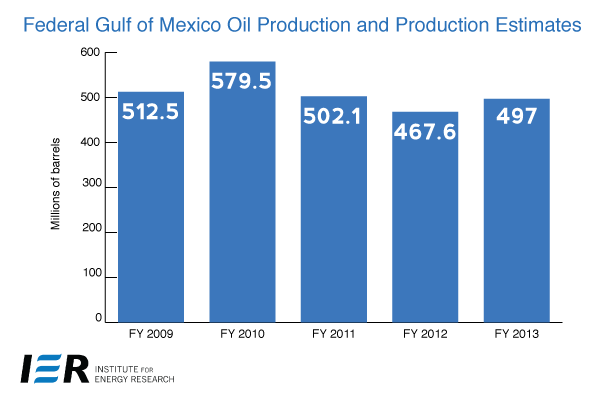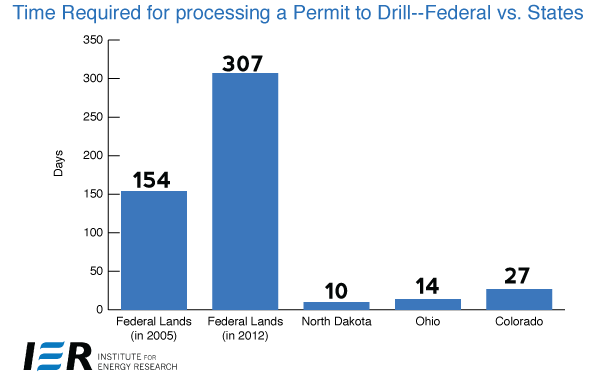The Energy Information Administration (EIA) is projecting that U.S. domestic crude oil production will increase to 6.8 million barrels per day in 2013, which is the highest level of production since 1993.[i] This is good news for Americans, and, of course, President Obama will try to take credit for it. But little of this increased oil production is in offshore waters of the Gulf of Mexico where most federal oil production occurs. In fact, federal Gulf of Mexico oil production decreased in fiscal year 2011 and then again in fiscal year 2012 due to the Obama Administration’s policies, particularly the moratorium on drilling and permitting that occurred after the Macondo accident and other policies as identified below.
Federal Oil Production Trends
According to EIA, in fiscal year 2011, production on federal lands dropped 13 percent from fiscal year 2010 levels, led by a drop in federal offshore production of 17 percent.[ii] The majority of oil production on federal lands (around 80 percent) is located in offshore waters. And the vast majority of federal offshore oil production (generally over 95 percent) is from the 55 percent of the Gulf of Mexico where leasing has been allowed. Thus, an analysis of oil production from the Federal Gulf of Mexico should be a good indicator of where our increased oil production is coming from—federal lands or private and state lands.
According to EIA, federal offshore production peaked in fiscal year 2010 with a total of 618 million barrels produced. In that year, about 580 million barrels of oil were produced in the federal waters of the Gulf of Mexico. But due mainly to the moratorium placed on offshore drilling by the Obama Administration, oil production in the federal waters of the Gulf of Mexico fell by 77 million barrels in fiscal year 2011 (13 percent). EIA is projecting it to fall again in fiscal year 2012 by another 35 million barrels (7 percent). (Note that these production volumes come from EIA’s Short-Term Energy Outlook and are a combination of data and projections for fiscal year 2012.) EIA expects fiscal year 2013 production from the federal waters in the Gulf of Mexico to begin to increase (by 6 percent), but not reach the oil production levels of either fiscal year 2010, when it peaked, nor fiscal year 2011, which had a half year of high production before the Macondo accident occurred and the moratorium on drilling was put in place.
Comparing the loss in federal oil production to production in the oil producing states, we find the decrease expected in oil production from the federal waters of the Gulf of Mexico between fiscal years 2010 and 2012 of 112 million barrels is about equal to the oil produced in the state of North Dakota in 2010 (113 million barrels) and it is 50 percent higher than the oil produced in the state of Oklahoma in 2011 (74 million barrels).
Source: Energy Information Administration, Short-Term Energy Outlook, http://www.eia.gov/forecasts/steo/data.cfm?type=tables
The moratorium helped to cut oil production from the Gulf of Mexico by over one-third. Before the accident, monthly oil production from the Gulf of Mexico was as high as 1.71 million barrels a day, and after the accident, it was as low as 1.09 million barrels per day, a reduction of over 600,000 barrels per day. Mainly because of the moratorium on drilling imposed by the Obama Administration, oil production from the Gulf of Mexico is expected to reach only 1.3 million barrels per day in 2012.[iii] Much of that oil is heavy oil being replaced by imports from Saudi Arabia.[iv]
The Congressional Research Service (CRS) found that the increased oil production in fiscal year 2011 came from oil production on private and state lands, which makes up about 70 percent of total U.S. oil production. According to CRS, 96 percent of the increase in oil production between fiscal years 2007 and 2012 came from private and state lands and production there increased 11 percent in fiscal year 2011 from fiscal year 2010 levels.[v] Oil producers prefer to explore for oil and drill on private and state lands because there is a lot less red tape involved and much shorter approval times, which means it is less costly to invest and drill for oil on state and private lands than on federal lands.
The Onshore and Offshore Records under the Obama Administration
The following information comes primarily from the Obama Administration websites—from the Bureau of Land Management, the Bureau of Ocean Energy Management and other Department of Interior websites.
The Record for Oil and Gas Leasing and Permitting on Federal Onshore Lands. The federal government leases less than 6 percent of its onshore lands for oil and gas development. Under the Obama Administration, the rate of leasing has slowed by about half. New acres leased between fiscal year 2006 and fiscal year 2008 dropped 55 percent from 11,635,373 to 5,283,441, and the number of new leases fell by 42 percent from 9,661 between fiscal years 2006 and 2008 to 5,568 between fiscal years 2009 and 2011. And, under President Obama’s administration, the total number of acres under lease fell by over 18 percent, from 47.2 million in fiscal year 2008 to 38.5 million in fiscal year 2011. The rate of permitting has also declined by more than one-third. During fiscal years 2006 to 2008, 20,479 federal drilling permits were approved, compared to 12, 821 for fiscal years 2009 to 2011.[vi] The time it takes to receive a permit to drill on federal lands has doubled since fiscal year 2005 when it took 154 days to receive a drilling permit compared to 307 days in fiscal year 2011. The Obama Administration issued almost 40 percent fewer permits and took twice the time to do it. Since fiscal year 2008, the amount of time that industry needs to take to “resolve any deficiencies” in an application has tripled.[vii]
By comparison, it takes only 10 days to receive a permit to drill on North Dakota state lands, where the shale oil boom has made North Dakota the second largest state oil producer in the United States. North Dakota is prospering with its unemployment rate at 3 percent and its economic growth rate at 7 percent. In Ohio, drilling permits are obtained in 14 days.[viii] And in Colorado, it takes 27 days to process a drilling permit application from its receipt to the permit issuance.[ix] Because each state has unique geography, topography, geology, hydrogeology and meteorology, the states are well suited to review these applications and they are light-years ahead of the federal government in terms of experience and know-how about their individual state lands.[x]
The Record for Oil and Gas Leasing and Permitting in Offshore Federal Waters. The United States has a vast amount of offshore acreage that could be leased for offshore drilling, but only 2 percent of the outer continental shelf is currently leased for oil and gas development, 35,275,233 acres out of 1,712,260,000 total acres.[xi] During the Obama Administration, revenues from the sales of offshore leases fell by well over 99 percent, from $9,481 million in fiscal year 2008 to below $37 million in fiscal year 2011[xii] due to cancelled and delayed lease sales. Both the number of acres and the number of tracts leased have declined by about two-thirds since President Obama has taken office. New acres leased between fiscal year 2006 and fiscal year 2008 totaled 17,880,416, while only 6,073,715 new acres were leased between fiscal years 2009 and 2011. The number of new tracts leased between fiscal years 2006 and 2008 totaled 3,248, dropping to 1,110 between fiscal years 2009 and 2011.[xiii]
The rate of offshore permitting declined by 62 percent with 995 new well permits approved between January 20, 2006 and January 19, 2009 dropping to 374 new well permit approvals between January 20, 2009 and January 19, 2012.[xiv] Further, it can be seen that the Obama Administration cancelled more lease sales than it has held by comparing the Outer Continental Leasing Program for 2007-2012 proposed in April 2007 and the lease sales schedule that the Bureau of Ocean Energy Management has on its website.[xv] And, according to the Congressional Research Service, the 15 lease sales to be offered in President Obama’s newest offshore lease plan for 2012 to 2017 is the lowest number since the process began in 1980 and is over 60 percent less than the number held during President Reagan’s first term.[xvi]
Conclusion
These statistics show that the trend during the Obama Administration has been toward fewer leases and permits for oil and gas drilling and a longer processing time before approval is attained in sharp contrast to state programs where permits are obtained in less than a month. Further, these Obama Administration policies along with its moratorium on drilling after the Macondo accident have reduced the amount of oil produced on federal lands that we Americans own. Gulf of Mexico oil production is not even expected to regain the peak it reached in 2010 by 2013, according to the EIA. If states can take less than a month to approve drilling permits on their lands, why does it take the federal government 307 days to reach approval? The record is becoming clear that the federal government is a poor steward of our national energy supplies and security.
[i] Energy Information Administration, Short-Term Energy Outlook, September 11, 2012, http://www.eia.gov/forecasts/steo/
[ii] Energy Information Administration, Sales of fossil Fuels Produced from Federal and Indian Lands, FY 2003 through FY 2011, March 2012, http://www.eia.gov/analysis/requests/federallands/pdf/eia-federallandsales.pdf
[iii] Energy Information Administration, Short-Term Energy Outlook, September 11, 2012, http://www.eia.gov/forecasts/steo/tables/?tableNumber=9
[iv]New York Times, U.S. Reliance on Oil from Saudi Arabia is Growing Again, August 16, 2012, http://www.nytimes.com/2012/08/17/business/energy-environment/us-reliance-on-saudi-oil-is-growing-again.html?_r=3
[v] Congressional Research Service, U.S. Crude Oil Production in Federal and Non-Federal Areas, March 20, 2012, http://freebeacon.com/wp-content/uploads/2012/03/R42432.pdf
[vi] Bureau of Land Management, Oil and Gas Statistics, http://www.blm.gov/pgdata/etc/medialib/blm/wo/MINERALS__REALTY__AND_RESOURCE_PROTECTION_/energy/oil___gas_statistics/data_sets.Par.69959.File.dat/table-01.pdf
[vii]Bureau of Land Management, Average Application for Permit to Drill Approval Timeframes: FY 2005-FY 2011, http://www.blm.gov/wo/st/en/prog/energy/oil_and_gas/statistics/apd_chart.html
[viii] Ohio Oil and Gas Summary 2011, http://ohiodnr.com/portals/11/publications/pdf/oilgas11.pdf
[ix] Natural Resources Division, memo to Colorado Oil and Gas Conservation Division, April 25, 2011, http://cogcc.state.co.us/announcements/CommissionLtr4_25_11.pdf
[x] Testimony before the U.S House of Representatives Subcommittee, May 31, 2012, http://files.dep.state.pa.us/AboutDEP/AboutDEPPortalFiles/RemarksAndTestimonies/DEP_Sec_Krancer_SUBCOMMITTEE_FINAL_TESTIMONY_5-30-12.pdf
[xi] Department of Interior, Outer Continental Shelf Planning Area Acreage, http://www.doi.gov/whatwedo/energy/ocs/upload/OCS-Planning-Area-Acres-REV-Oct-8-2008.pdf and Bureau of Ocean Energy Management, Combined Leasing Report, August 1, 2012, http://www.boem.gov/uploadedFiles/BOEM/Oil_and_Gas_Energy_Program/Leasing/Combined_Leasing_Status_Report/08012012LeaseStats.pdf
[xii] Office of Natural Resources Revenue, http://www.onrr.gov/ONRRWebStats/Disbursements_Royalties.aspx?report=ReportedRoyaltyRevenuebyCategory&yeartype=FY&year=2011&datetype=AY
[xiii] Bureau of Ocean Energy Management, Outer Continental Shelf Lease Sale Statistics, April 27, 2012, http://www.boem.gov/Oil-and-Gas-Energy-Program/Leasing/Regional-Leasing/Outer-Continental-Shelf-Lease-Sale-Statistics.aspx
[xiv] Bureau of Safety and Environmental Enforcement, http://www.data.bsee.gov/homepg/data_center/plans/apdcombined/master.asp
[xv] Bureau of Ocean Energy Management, 2007-2012 Lease Sale Schedule, http://www.boem.gov/Oil-and-Gas-Energy-Program/Leasing/Five-Year-Program/2007-2012-Lease-Sale-Schedule.aspx and Proposed Final Program outer Continental Shelf Oil and Gas Leasing Program 2007-2012, April 2007, http://www.boemre.gov/5-year/PDFs/MMSProposedFinalProgram2007-2012.pdf
[xvi] Congressional Research Service, Memorandum on List of Submissions to Congress Under Section 18 of the Outer Continental Shelf Lands Act, July 16, 2012, http://naturalresources.house.gov/uploadedfiles/crs-doi5yrsec18submissions07-16-12.pdf





